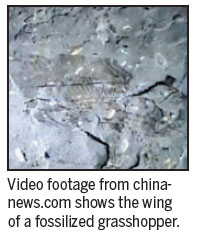A student at the Nanjing Institute of Geology and Paleontology under the Chinese Academy of Sciences has discovered a 120 million-year-old fossil that belonged to an ancestor of the modern long-horned grasshopper.
The fossil, found in Yumen in Gansu province, preserved a 3-centimenter section of the ancient insect's wing.

"Most insects only have their wings preserved in the fossils," said Wang He, who unearthed the fossil. "their bodies, unlike the wings, were easily decomposed or eaten by other creatures."
"Judging from the wing, the strata where the fossil was found and the nearby associated fossils, we can be sure that the insect was the ancestor of the modern katydid," said Wang, who is doing post-graduate work at the institute.
The structure of the wing indicates the ancient insect could sing like the modern ones, though the modern katydid has weaker wings and reproductive organs than its ancestor, Wang said.
Zhang Haichun, a paleontology professor at the institute, said fossils of the orthopteran family Prophalangopsidae have only been found in other parts of China and other regions of the world.
"Such insects have not been found in Gansu province before," Zhang said. "It indicates that the province, which is dry now, used to be humid and full of water systems, because the insects need to grow in a humid environment."
He said the insects lived in the Cretaceous Period, when the world's earliest flowers began to appear, and they ate flowers and plant leaves.
The fossil is kept at the institute, which has proper preservation facilities. Some slabs bearing fossils found in northwest China still contain salt and could swell and break into pieces if the salt absorbed moisture.


















































